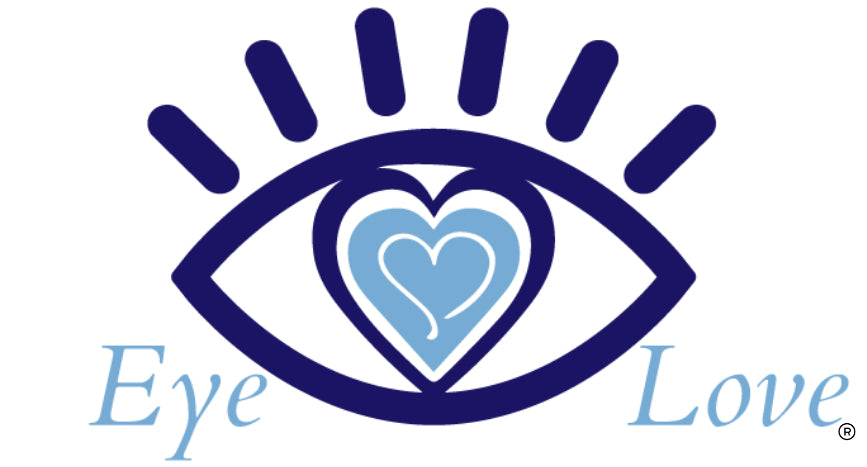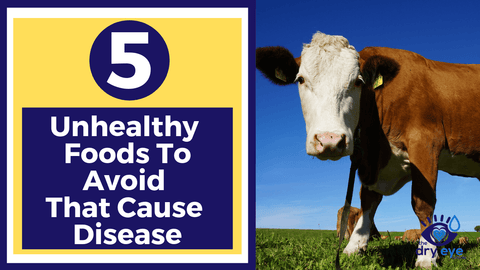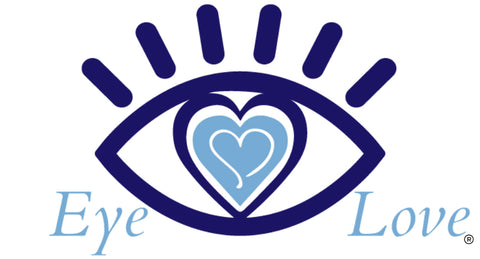What Are The Best Foods To Eat For Health?
We have discussed in great length the role that inflammation plays in chronic disease.
Inflammation is a BIG deal. Most disease is some form of inflammation, so battling inflammation is a key component to supporting your eye and overall health. An estimated 80% of visits to doctor’s offices are for issues relating to a chronic disease, which stems from chronic inflammation of the body. The CDC states that 7 out of every 10 Americans die of chronic disease.
What you put in your body is single-handedly the most important thing you can focus on to support your eyes.
In this article we are going to discuss foods that contribute to disease and how to eliminate them.
But I Can’t Live Without.... [INSERT WHATEVER FOOD HERE]!! - MYTH
Before we dive into what to eat, please take note. If you have not eaten like this before your body has adapted to eating meat, dairy, and processed food. Much like a long term smoker goes through a detoxification, you will also go through a detoxification in which your body may develop rashes, headaches, shakes, phlegm, sleeplessness, constipation, diarrhea, or other forms of discomfort. YOU WILL GET THROUGH THIS.
Foods That Cause Disease | What Foods To Eliminate?
Filling your diet with foods that are nutritionally deficient and have high saturated fats is the quickest way to derail the balance of your body. If your body is busy fighting the damage caused from foods like ice cream, hamburgers, and pepperoni pizza after meal times, then you will lack energy, feel depressed, and want to sleep due to all energy being exerted to the meal you just had.
DON’T WORRY, though. If you’ve eaten terribly your whole life, it is not too late. Choose to turn the switch now to a healthier lifestyle and accept the challenges that come with it. Start eating healthy today and your body will heal your past wrongdoings, because of its incredible ability to heal.
This will be a tough challenge, so I always recommend a cheat day. This is 12 hours in which you can eat anything and everything you have been craving that whole week. Make it count, but then go back to the healthy, feel better foods for the other 156 hours in a week.
Try this out for a test… For a full day make a green smoothie for breakfast, lunch, and dinner. Write down the answers to the following questions:
Did I feel tired all day?
Did I feel like I needed an afternoon nap?
Was I unmotivated to do my most important work at my job?
Did I poop?
Was I bloated?
Did I feel like drinking more caffeine to stay awake?
Did I experience cramping?
How did I feel the day after I ate all this?
Now eat eggs, bacon, and toast for breakfast, a hamburger and fries for lunch, and a chicken breast with potatoes for dinner. Answer the same questions above.
So, What Foods Should I Avoid?
You have been eating the wrong foods for almost your whole life. However it is NOT your fault. It is the government, factory farms, and large companies that are to blame. These are the people that told you “Eat meat for strength,” “The other white meat,” “Drink milk for healthy bones,” “Got Milk?” and “Eat fortified bread and cereal for your vitamins.”
Meat, dairy, and processed foods like cereal and bread are toxic to your body. They’re clogging your arteries, raising your blood pressure, and pumping you full of cholesterol, toxins, hormones, and antibiotics that you don’t need. According to the World Health Organization (WHO), a diet high in animal products such as meat, dairy, and eggs, as well as high in sugar-laden and fat-laden processed foods such as breads, cereals, chips, cakes, and cookies, cause an increase in the acidity of your body, which causes bodywide inflammation. Diets that are heavy in these sources (animal products and processed foods) cause 80% of cardiovascular disease, more than 33% of all cancers, and virtually all obesity and type 2 diabetes in this country.
Heart disease, for example, is the number one killer of women in the United States and is linked to high amounts of saturated fat in animal products. But it doesn’t just clog up your arteries around your heart (heart disease). It clogs up ALL your arteries, leading to strokes, cancer, and tissue death due to lack of oxygen.
First Food To Avoid: Meat

Meat carries numerous hormones, antibiotics, pesticides, pollutants, bacteria, and viruses into your body. We store all this in our body fat, so it continues to fester inside our body even after it’s been digested. When you stop eating meat, you stop eating extra hormones, prevent antibiotic overdose, avoid toxic pesticides, eliminate dangerous pollutants, and decrease exposure to scary viruses and bacteria.
The FDA and USDA allow factory farmers to use hormones to promote growth and milk production in their cattle. Two out of every three cattle raised for slaughter are treated with natural and synthetic forms of estrogen and progesterone and other hormones linked to breast cancer and colon cancer in humans. These hormones cause a slew of problems and affect the entire food chain as they get passed on to humans that consume the animal product, the surrounding ecosystem including plants and fish soak up the hormones as well causing an imbalance in humans.
Due to the crowded nature of factory farms, livestock is literally standing in feet of its own fecal matter which is filled with bacteria and can cause widespread illness among the livestock. To combat this, factory farmers mix low dose antibiotics into the feed and water. 80% of all antibiotics in the US are sold to farmers for this purpose. Massive resistance to these antibiotics is a huge problem that could potentially extinct the human population (words for a different book). These are given to all livestock to prevent disease in these crowded and unsanitary conditions.
Factory farmers use toxic pesticides to ward off insects, kill weeds, and protect their financial investment. This is the same feed that is mixed with antibiotics and hormones to feed the livestock. We can usually wash most of this off our produce or not use it at all with organic produce, but animals absorb the pesticides in the food they eat, which ends up in your dinner.
Persistent organic pollutants (POPs) are environmental chemicals from industrial processes, pharmaceuticals, and pesticides that have soaked into the water supply and soil. These POPs accumulate and continue moving up the food chain to you. 89% of our POP intake comes from meat sources and dairy, including eggs and fish. Some POPs like dioxins, are Group 1 carcinogens, and cling to animal fats. Even low level exposure has been shown to increase the incidence of infertility, diabetes, learning disabilities, immune system suppression, and lung problems.
Finally, according to the USDA, 70% of foodborne illness in the US is from meat that is contaminated with bacteria like E.coli, listeria, and campylobacter. This is most likely due to these animals being fed food that is not meant to be digested in their intestines (grain versus grass). Due to poor slaughtering practices, intestinal contents (poop) splash across meat and contaminate it.
Aren’t you excited for all of the hormones, antibiotics, pesticides, pollutants, and bacteria that are on the plate of beef, chicken or pork waiting for your consumption?
What About Fish?
Most fish have become too toxic to consume. Oceans are slowly becoming so polluted with garbage that fish are beginning to eat our garbage as part of their diet and it is showing up further up the food line when we consume the fish. Fish also contain high levels of mercury, organochlorines, polychlorinated biphenyls (PCBs) and other toxins that can wreak havoc on your body.
Taking an omega-3 supplement helps reduce toxicities if taking a high quality one like our Heyedrate Omega-3 for Eye Health.
What About Eggs?
Eggs contain lutein, omega-3, and protein. They are an extremely viable source of all three, but there are plant-based substitutes that are even better like those listed above.
My final thoughts on meat... If you still, after reading that, want to eat meat or have to have it, consider only eating organic, free-range, and local meat where you know where it is coming from. Do we still eat meat? Yes, about once a month. If you feel like you have to eat it daily, limit it to dinner only.
I will challenge you to try a meatless week and see how you feel. Later on we will discuss different ideas for breakfast, lunch, snacks, and dinner.
Foods to eliminate = meat
- Beef
- Chicken
- Pork
- Fish
- Eggs
Second Food to Avoid: Dairy

Like meat, dairy contains growth hormones and antibiotics due to animal treatment explained above. Dairy has also been shown to cause inflammation which leads to life-threatening illness like MS, type 1 diabetes, rheumatoid arthritis, and hyperthyroidism.
Consider that humans are the only animals on the planet that consume another species’ milk. Cow’s milk is a fairly recent addition to our diets. Milk protein is hard for humans to digest, if they can digest it at all, which triggers an autoimmune attack and inflammation in the body.
Dairy products are also our biggest sources of saturated fats and sugar. Lactose, which is the sugar in milk, contributes the same calorie load as soda ounce for ounce according to Neal Barnard, president of the Physicians Committee for Responsible Medicine.
Third Food to Avoid: Sugar

Sugar causes inflammation, makes you overweight, leads to diabetes, and is linked to cancer. How do you feel after consuming that sugary cookie, cake, or donut? I feel like garbage and I’m sure you do too. Headaches, mood swings, depression, and more are symptoms of sugar intake.
Don’t worry though, nature makes its own sweets. I challenge you to throw away all the white, brown, and powdered sugar in your cabinet, along with all the foods that contain these harmful granules. After that do not eat anything with added sugar for a week. If you get a craving, reach for a nice bowl of ripe berries or frozen grapes, or better yet, make some banana ice cream.
Refined sugar - along with dextrose, maltose, evaporated cane juice, high-fructose corn syrup, and agave - can take your body on a blood sugar roller coaster, which sends your pancreas into a insulin producing craze, which increases your risk significantly for diabetes. Type 2 diabetes is when your insulin production cannot keep up with the sugar load and your pancreas may stop working. This sugar roller coaster will also cause depression, mood swings, and craving for more sugar creating a never ending cycle.
Artificial Sweeteners are chemical products made in a lab that have no long term studies on the effects on the human body. Avoid these at all costs. This includes NutraSweet, Equal, Sweet ’N Low, Splenda, and Stevia.
Fourth Food to Avoid: Processed Foods

Any food that comes in a box, bag, or can, which has a mile long list of ingredients, that can sit unrefrigerated for days, is not good for you. If you have trouble pronouncing an ingredient, it is most likely not good for you.
Trans fats, or partially hydrogenated oils, became popular because they kept cakes, doughnuts, french fries, and cookies fresh longer and feel less greasy. But these artificial oils are just a processed vegetable oil that is solidified. These lead to an increase in cholesterol and inflammation. Common culprits that you have heard of are margarine and Crisco (watch out for partially hydrogenated oil in peanut butter - it should only contain peanuts and maybe a little bit of salt!)
Excitotoxins, such as MSG (monosodium glutamate), corn protein, glutamate, gelatin, wheat protein, yeast extract, and autolyzed yeast, are used for flavoring and can cause all sorts of problems like asthma, autism, ADD/ADHD, hyperactivity, and diabetes. The common culprits to avoid that contain excitotoxins are frozen meals, canned soups, chips, crackers, sauces, dressings, candy, gum, soda, and CHILDREN’s snack food and BABY food. Yikes!
Fifth Food to Avoid: Genetically Modified Organisms (GMOs), Pesticides, and Fertilizers

Genetically Modified Organisms (GMOs) are simply foods or organisms that have been altered from their natural state to help combat heavy pesticide use, extreme temperatures, resist disease, and/or to battle insects. GMO labeling is required in 64 countries, but the United States and Canada do not require it because of corporate pressure.
The most common GMO plants are corn, soybeans, cotton, potato, alfalfa, canola, papaya, squash, apple, and sugar beet. According to TIME magazine more than 90% of all soybean, cotton, and corn acreage in the US is used to grow genetically engineered crops.
20 years ago, no genetically modified foods existed.
So what is the big deal with GMO’s?
Crops are not genetically modified for nutritional reasons. They’re modified for economic reasons. Faster growth, with pesticide resistance so they can add more pesticides during growth. Pesticide use continues to rise due to the creation of superweeds and hard-to-kill insects that are becoming resistant to pesticides.
Fertilizers are also used to provide much needed nutrients to soils that used to exist prior to the use of pesticides. Multiple USDA studies reveal that the food currently grown on America’s chemical-intensive factory farms contain drastically less vitamins and essential minerals than the food produced 50 years ago (when pesticides and fertilizers were not used as frequently).
Most food coming from factory farms is nutritionally deficient, laced with pesticides, antibiotics, hormones, harmful bacteria and viruses, genetically modified organisms (GMOs), and toxic chemicals. Factory farms and traditional product from these farms are a hazard to your health.
How to Avoid GMO’s, Pesticides, & Fertilizers
Simply buy organic or foods labeled non-GMO, know the farmer you're buying from (like farmer’s markets), plant a garden, and eliminate the ten crops listed above from your diet.
For an easy start, go by the Environmental Working Group’s Dirty Dozen and Clean Fifteen. However, for the easiest way to think about this just always buy organic, which is what we do.
ALWAYS buy organic when it comes to the Dirty Dozen which includes strawberries, spinach, nectarines, apples, peaches, celery, grapes, pears, cherries, tomatoes, sweet bell peppers, and potatoes. Avoid these items if they are not organic.
The Clean Fifteen should still be bought organic if possible, but they have less pesticide residue compared to other produce. This list includes sweet corn, avocados, pineapple, cabbage, onions, sweet peas, papayas, asparagus, mangoes, eggplant, honeydew melon, kiwi, cantaloupe, cauliflower, and grapefruit.
Pesticide side effects include nausea, vomiting, diarrhea, stomach cramps, headache, dizziness, weakness, confusion, excessive sweating, chills, thirst, chest pains, difficulty breathing, cramps in your muscles, and aches all over your body.
Final Thoughts
We've really dug down deep into all of the foods that you should avoid if you want to get healthy. I know very well that this article won't be popular with mainstream society because we're all so used to hearing how healthy meat and dairy are. We're all so used to this propaganda that it's truly tough to ignore it and do your own thing.
However, I encourage you to take one of the bad things on this list and eliminate it from your diet. If that's meat, great! If it's processed, sugary foods, that's awesome!
Take this one step at a time, eliminating one bad food at a time, and you'll quickly find how easy it is to go without these things. In addition, you'll begin to feel great and your eyes will begin to thank you for finally giving them the nutrients they need to function and be healthy.
We, Eye Love, LLC, are a participant in the Amazon Services LLC Associates Program, an affiliate advertising program designed to provide a means for us to earn fees by linking to Amazon.com and affiliated sites. MediViz and Heyedrate branded products are made by our company, Eye Love, but we truly believe that our products are the best on the market! It is important to know that our products are not intended to diagnose, treat, cure, or prevent any disease.





